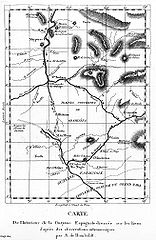| Meeting 12 • 16 February 2012 • Thursday |
Version: |
|
picture of the week |
thought-bite of the week: |
|
|
"Rivers have only a slight, often imperceptible fall.… We stopped by the mouth of the Caño de la Triguera… to measure the speed of the current, which was 2.56 feet an hour." |
|
mini-text of the week (start): "In this interior of a new continent you get used to seeing man as not essential to the natural order…" Humboldt, "Personal Narrative", from Jaguars and Electric Eels, ed. & trans. Wilson, pp. 99-100 (read more) |
|
(X') = anticipated time in minutes (total=75) |
(0001) etc.=item in Humboldt Project document collection |
|
Key to notes added AFTER the class meets: |
|
|
√ = topic / activity that was adequately dealt with during the class |
+ = topic that was started but needs more attention & will be resumed at next / subsequent meeting(s) |
|
- = a topic / activity that was proposed though not begun, but will be taken up later |
|
|
Italic bold green text like this = comments after the meeting |
|
|
√ |
(3') This week's thought-bite and mini-text: the vast uncharted expanses, the constant measuring and the tiny gradations. Science shows that Kansas is flatter than a pancake. The globe is flat (as a spherical surface, that is - to a tolerance of less than 1/1000, closer than an orange). (Thomas Friedman: The World Is Flat - others say it is round, spiked, tilted). topographic mapping |
|
√ |
(2') NEW ON WEBSITE (review from meeting #1, due to recalcitrant technology): "Related Events" (linked from TOC) and "PSU Sustainability Calendar"• Wednesday, February 22, 5-6:30 pm "Payment for Ecosystem Services in the Ecuadorian Andes,"Kathleen Farley, San Diego State University PSU Institute for Sustainable Solutions job opportunities through the ISS - this course adds to your competitive advantage (if you're doing OK in it). Projects like (maybe) yours recently won financial support from PSU. |
|
+ |
(15') Humboldt's pioneering work in plant (and animal) geography: the 99% perspiration and data are combined with 1% inspiration and insight to produce the monumental, iconic "Chimborazo" graphic.
Special points (more about importance of data and how it is obtained): natural history collections; rarity of travel; topographic mapping (Wikipedia; Geosciences, Idaho State U) |
|
+ |
(20') Exploring group projects (continuation of previous meeting): a) trial organization of groups by categories (majors? definite ideas already for projects? math people? foodies? outdoor interests? making things? travel background? hobbies?) b) re-grouping according to suggested projects: OMSI Planet under Pressure; PSU Earth Day; Earth Day with Alex at a Humboldt-named school; designing a Humboldt-related learning garden or specimen collection; planning initial contact with Humboldt-named schools; researching Humboldt-named schools; re-branding a Humboldt-named school (colors, totem animal /plant, mascot & costume, rally/same implement, cheer, events); familiarizing stakeholders with Humboldt; planning the model "Humboldt Box"; adaption of lesson plans for Humboldt-related content (organized according to subject area, or according to age level); grant research and draft proposal. Here is Enchanted Learning - but one of many sources of learning activities, especially for younger learners. Here's their "Explorers" page about Humboldt. Here's their section about "astronomy:Earth", with activities that could be inspiration for learning activities for Humboldt-named schools. Here is "ThirteenEd Online", about lesson plans (example: math). There are countless lesson plans for climbing walls + math, ••. LessonPlanet has reviews of climbing wall lesson plans, including activities that simulate the climbing done by Lewis & Clark, or climbing up Kilimanjaro to learn about ecological zones. |
|
+ |
(15) Followup on reading Darwin: Geneva Convention, Federalist Papers, maybe Hobbes/Locke/ Smith, probably not Newton. A question raised at the previous meeting: What can we trust? Can we even trust the Helferich book? Where do we get our information and how do we judge it (and the opinions, conclusions, solutions it presents to us)? Example: The lightning strike in Norwich, the argument about Franklin and his lightning rods, and an example from our time (genetic engineering of crop species and possible harm to environment). Examples from our lives: your medications, like for a cold: what to take; how much; whether it will work; whether what's in the pill is what's on the label; your money: commercial bank vs. credit union; planning for adult life, including career choice (ethical company?), fringe benefits, employer-paid education, charity matching, retirement; weather (examples: driving to California, flying to DC in mid-winter); climate change?! Examples of "cognitive traps": availability bias; hindsight bias; confirmation bias; contamination effects (distraction by irrelevant but proximate information); overconfidence in calibration (precision ≠ accuracy; best-case scenario ≠ most probable outcome) (source: R0303, Ferguson, Ascent of Money). Small groups: Where do you get your own information, opinions, conclusions, solutions, and how do you check it out. If time: So what can the educated citizen read while we wait to see what today's classics will be in the eyes of tomorrow's inhabitants? (periodical press; local, quotidien; long-term knowledge). How do educated citizens become capable writers? |
|
_ |
(5') Preview of writing assignment #4: Research and describe a Humboldt-related species for a specific audience. Will be activated next meeting and due Tuesday, 6 March. |
|
(5') Checkups & Previews: ••See "schedule and assignments" page (week 4) for directions about getting smart phone apps for the course. (WWHD?) Upcoming: presentation about society back then (and any time before 1800 or so), to help understand how H related to people of other classes / races (teaser: When was it that someone's ears first popped with a change in altitude?) Focus of "interpreting the past" |


